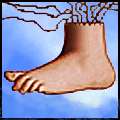© 2006 All Rights Reserved. Do not distribute or repurpose this work without written permission from the copyright holder(s).
Printed from https://danginteresting.com/retired/cholesterols-achilles-heel/
This article is marked as 'retired'. The information here may be out of date, incomplete, and/or incorrect.

A joke for those of you who like puns.
A chiropractor has been in practice for many years when he realizes that a couple of his patients with the same back problem also have the same unusual facial tic. Intrigued he starts taking pictures of his patients’ faces and correlating them with their diagnoses. The result is a comprehensive diagnostic manual showing doctors which spinal problems to look for, based on their patients’ facial habits. He titles it Face, The Spinal Frontier.
This joke may have made the rounds at the Manchester Royal Infirmary. It’s as good an explanation as any for how Dr. Paul N. Durrington and colleagues managed to think of correlating Achilles tendonitis and blood chemistry – coming up with some startling results.
Heterozygous familial hypercholesterolemia (HeFH) is a genetic condition affecting the removal of cholesterol from the blood. Dr. Durrington calls it “the most common genetic disorder in Europe and the USA affecting 1 in 500 people.” People with HeFH have inherited a tendency for high cholesterol, which makes them far more vulnerable to early heart disease. Since high cholesterol in and of itself has no symptoms unless the levels are truly extraordinary, HeFH is often not diagnosed until later in life, leaving the sufferers at even higher risk as their cholesterol levels go undiagnosed and untreated. This makes finding an early screening method, or some other way to bring possible HeFH patients to their physicians’ attention, an important goal.
Now there may be a way to find at least some of those patients. Dr. Durrington and colleagues examined a population of 133 heart patients with HeFH and 87 of their domestic partners, looking for a history of heel pain. The result? Sixty-seven of the heart patients (47%) had experienced significant heel pain (defined as an episode lasting three or more days) at least once, as opposed to only six of their partners (7%). The most interesting point of the correlation though, is that the researchers were looking for episodes of pain that occurred before the patients’ diagnosis with HeFH. In many cases, the reported episodes of heel pain had occurred years before the patient was ever checked for high cholesterol.
Dr. Durrington hypothesizes that this startling result may be because of a common effect of HeFH. The high cholesterol levels in the blood can lead to the deposit of cholesterol on tendons as well as in the arteries, leading to pain and inflammation – in other words, tendonitis.
What makes this study so potentially valuable is that the Achilles tendonitis can occur far in advance of any symptoms of heart disease. While screening younger patients with tendonitis for high cholesterol would still leave many HeFH sufferers undetected, it has the potential to catch others well before they enter the symptomatic stages of heart disease. With early treatment, some may be able to avoid cardiovascular trouble for many years, if not altogether.
Given the nature of medicine and new studies, it may be some while before doctors begin to alter their usual routines for checking on their patients’ cholesterol levels. As for myself, I’m going to be advising my friends and relatives with Achilles tendonitis to have their cholesterol checked.
© 2006 All Rights Reserved. Do not distribute or repurpose this work without written permission from the copyright holder(s).
Printed from https://danginteresting.com/retired/cholesterols-achilles-heel/
Since you enjoyed our work enough to print it out, and read it clear to the end, would you consider donating a few dollars at https://danginteresting.com/donate ?